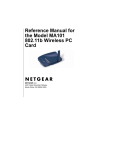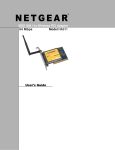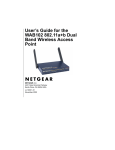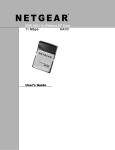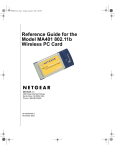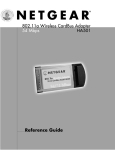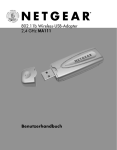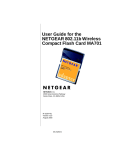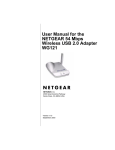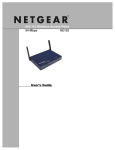Download Netgear MA311 User Guide
Transcript
NETGEAR ® IEEE 802.11b Wireless PCI Adapter 11 Mbps Model MA311 User’s Guide i © 2002 by NETGEAR, Inc. All rights reserved. Trademarks ©2002 NETGEAR, Inc. NETGEAR® , the Netgear Logo, the Gear Guy, and Everybody's connecting are trademarks or registered trademarks of Netgear, Inc. in the United States and/or other countries. Microsoft, Windows, and the Windows logo are trademarks, or registered trademarks of Microsoft Corporation in the United States and/or other countries. Other brand and product names are trademarks or registered trademarks of their respective holders. Information is subject to change without notice. All rights reserved. Certificate of the Manufacturer/Importer It is hereby certified that the Model MA311 Wireless PCI Adapter has been suppressed in accordance with the conditions set out in the BMPT- AmtsblVfg 243/1991 and Vfg 46/1992. The operation of some equipment (for example, test transmitters) in accordance with the regulations may, however, be subject to certain restrictions. Please refer to the notes in the operating instructions. Federal Office for Telecommunications Approvals has been notified of the placing of this equipment on the market and has been granted the right to test the series for compliance with the regulations. VCCI Statement This equipment is in the Class B category (information equipment to be used in a residential area or an adjacent area thereto) and conforms to the standards set by the Voluntary Control Council for Interference by Data Processing Equipment and Electronic Office Machines aimed at preventing radio interference in such residential areas. When used near a radio or TV receiver, it may become the cause of radio interference. Read instructions for correct handling. Federal Communications Commission (FCC) Compliance Notice: Radio Frequency Notice This device complies with part 15 of the FCC Rules. Operation is subject to the following two conditions: 1. This device may not cause harmful interference. 2. This device must accept any interference received, including interference that may cause undesired operation. Note: This equipment has been tested and found to comply with the limits for a Class B digital device, pursuant to part 15 of the FCC Rules. These limits are designed to provide reasonable protection against harmful interference in a residential installation. This equipment generates, uses, and can radiate radio frequency energy and, if not installed and used in accordance with the instructions, may cause harmful interference to radio communications. However, there is no guarantee that interference will not occur in a particular installation. If this equipment does cause harmful interference to radio or television reception, which can be determined by turning the equipment off and on, the user is encouraged to try to correct the interference by one or more of the following measures: (1) Reorient or relocate the receiving antenna, (2) Increase the separation between the equipment and receiver, (3) Connect the equipment into an outlet on a circuit different from that to which the receiver is connected, (4) Consult the dealer or an experienced radio/TV technician for help. Federal Communications Commission (FCC) Radiation Exposure Statement This equipment complies with FCC radiation exposure limits set forth for an uncontrolled environment. In order to avoid the possibility of exceeding the FCC radio frequency exposure limits, human proximity to the antenna shall not be less than 20 cm (8 inches) during normal operation. Canadian Department of Communications Radio Interference Regulations This digital apparatus (Model MA311 Wireless PCI Adapter) does not exceed the Class B limits for radio-noise emissions from digital apparatus as set out in the Radio Interference Regulations of the Canadian Department of Communications. SM-MA311NA-2 ii CONTENTS CHAPTER 1: INTRODUCTION ......................................................................................... 1 FEATURES AND BENEFITS ...........................................................................................................1 APPLICATIONS ...............................................................................................................................1 RELATED NETGEAR PRODUCTS .................................................................................................2 CHAPTER 2: INSTALLING THE DRIVERS AND UTILITY FOR WINDOWS 98, ME, 2000, AND XP...................................................................................................................................... 3 CHAPTER 3: HARDWARE INSTALLATION..................................................................... 7 PACKAGE CONTENTS ...................................................................................................................2 HARDWARE DESCRIPTION............................................. ERROR! BOOKMARK NOT DEFINED. INSTALLING THE WIRELESS PCI ADAPTER ...............................................................................7 CHAPTER 4: VERIFYING DRIVER INSTALLATION ........................................................ 8 Verifying Driver Installation under Windows 98 ............................................................................8 Verifying Driver Installation under Windows Me ...........................................................................8 Verifying Driver Installation under Windows 2000 ........................................................................8 Verifying Driver Installation under Windows XP ...........................................................................8 CHAPTER 5: INSTALLING THE DRIVERS AND UTILITY FOR WINDOWS NT............. 10 Installing Drivers Software for Windows NT ...............................................................................10 Verifying Driver Installation .........................................................................................................11 CHAPTER 6: WIRELESS LAN CONFIGURATION ......................................................... 15 WLAN CONFIGURATION UTILITY ...............................................................................................15 System Tray Applications (for all Windows users) .....................................................................17 WLAN Utility Parameter Modification .........................................................................................18 Profile..........................................................................................................................................19 Security (WEP) ...........................................................................................................................21 ADAPTER PROPERTIES CONFIGURATION...............................................................................24 Device Properties Page ..............................................................................................................24 Device Properties Modification ...................................................................................................25 CHAPTER 7: WIRELESS NETWORK FUNDAMENTALS .............................................. 27 WIRELESS NETWORK CONFIGURATION ..................................................................................27 Ad-hoc Mode (Peer-to-Peer Workgroup)....................................................................................27 Infrastructure Mode.....................................................................................................................27 SERVICE SET IDENTIFICATION (SSID) ......................................................................................28 AUTHENTICATION AND WEP ENCRYPTION .............................................................................28 WIRELESS CHANNEL SELECTION .............................................................................................29 APPENDIX A: HARDWARE SPECIFICATIONS ............................................................. 30 iii CHAPTER 1: INTRODUCTION With NETGEAR's MA311 802.11b Wireless PCI Adapter, you can effortlessly network any desktop PC and avoid the hassles of traditional Ethernet wiring. This adapter helps you create a wireless network for sharing your broadband cable or DSL Internet access among multiple PCs in and around your home or office. It is designed for desktop computers equipped with PCI slots running Microsoft Windows, and is equipped with auto-sensing capability that allows packet transfer at 11 Mbps for maximum throughput, or will automatically adjust at the lower speeds for distance or for operating in a noisy environment. Features and Benefits Quickly networks your employees without the time or expense of Ethernet cabling. Networks from any location in and around the home or office. Gives you constant access to corporate resources, e-mail and the intranet. Supports the vast majority of desktop PCs. Direct Sequence Spread Spectrum (DSSS) technology provides robust, interference-resistant and secure wireless connectivity. Supports 1, 2, 5.5, and 11 Mbps data rates. Connects seamlessly to wired Ethernet and PC network LANs to augment existing networks quickly and easily. Provides greater flexibility to locate or move networked PCs. Enables wireless networking to eliminate the cost of cabling. Plug and Play makes it easy to install. Features low power consumption. Reliable IEEE 802.11b standards-based wireless technology. Delivers up to 11 Mbps speed rate. Wireless nodes negotiate to operate in the optimal data transfer rate. In a noisy environment or when the distance between the wireless nodes is far, the wireless nodes automatically adjusts to operate at the optimal speed. Supports data encryption up to 128-bit shared key method. You can also select 64-bit or no encryption for faster data transfer rate. Supports multiple operating system platforms, including Microsoft Windows 98, Windows NT, Windows Me, Windows 2000 and Windows XP. Applications NETGEAR's MA311 Wireless PCI Adapter offers a fast, reliable, cost-effective solution for wireless client access to the network in applications like these: 1. Remote access to corporate network information E-mail, file transfer and Intranet access. 2. Difficult-to-wire environments Historical or old buildings, asbestos installations, and open areas where wiring is difficult to deploy 3. Frequently changing environments Retailers, manufacturers, and those who frequently rearrange the workplace or change locations 1 4. Database access Doctors, nurses, retailers needing mobile database access while in the hospital, retail store or office campus 5. SOHO (Small Office and Home Office) users SOHO users needing easy and quick installation of a small computer network Package Contents The product package should contain: MA311 802.11b Wireless PCI Adapter with an integral antenna MA311 Resource CD with Windows Drivers Quick Installation Guide Support Information Card Warranty and Registration Card Please call your reseller or customer support in your area if there are any wrong, missing, or damaged parts. You can refer to the Support Information Card for the telephone number of customer support in your area. You should keep the Support Information Card, along with the original packing materials, and use the packing materials to repack the MA311 Wireless PCI Adapter if you need to return it for repair. To qualify for product updates, product support, and product warranty registrations, register online on the NETGEAR Web page at: http://www.NETGEAR.com. Related NETGEAR products MA401 802.11b Wireless PC Card PS111W 802.11b Wireless-Ready Print Server ME102 802.11b Wireless Access Point MR314 802.11b Wireless Cable/DSL Router MA701 802.11b Wireless Compact Flash Card 2 CHAPTER 2: Installing the Drivers and Utility for Windows 98, Me, 2000, and XP Important: Please install the MA311 drivers and utility BEFORE installing the MA311 hardware. Make sure the MA311 Adapter is NOT plugged into the PCI slot while you are performing the following procedures. NT users: Please see “Chapter 5: Installing the Drivers and Utility for Windows NT” 1. Power ON your computer. Insert the MA311 PCI Adapter Resource CD into the CD-ROM drive. Click Start, Run and type ‘d:\setup’ if ‘d’ is the designation of your CD drive. 2. When the Welcome screen appears, click Next. 3 3. The Choose Destination Location screen displays the default Destination Folder. If you want to change the default folder, you can click Browse and choose a different destination folder. Click Next to go to the next screen. 4 4. The Select Program Folder screen appears. Accept or change the default folder name and click Next to continue. 5 5. Click Finish to complete the utility installation. The next chapter, Chapter 3: Hardware Installation, explains how to complete the MA311 PCI Adapter installation. 6 CHAPTER 3: Hardware Installation Installing the Wireless PCI Adapter Important: Be sure to install the MA311 drivers and utility BEFORE installing the MA311 hardware 1. 2. 3. 4. 5. Turn the power OFF and unplug the power cord from your computer. Remove the PC cover. Choose an available PCI slot (PCI slots are the shorter slots) and remove the corresponding back plate from the PC chassis. Insert the MA311 PCI Adapter into the PCI slot and fasten the adapter card to the computer chassis by reinstalling and tightening the screw removed in step 3. Power ON your desktop PC. The Found New Hardware Wizard dialog box appears. Windows will automatically detect the MA311 PCI Adapter and look for the driver. (only applies to Windows 98, Me, 2000 and XP) 6. 7. 8. For Windows 2000, a Digital Signature Not Found message may appear. Click Yes to proceed. For Windows XP, a Windows Logo Testing Not Found dialog box may appear. Click Continue Anyway to proceed. Click Finish to complete the installation. The Hardware Installation is complete. Your MA311 PCI Adapter is now ready for use. The Wireless LINK LED on the MA311 indicates the wireless link condition of the station with another wireless node or the associated access point. LINK LED Solid Green – Associated with the Access Point or 802.11 Ad-Hoc wireless workstation Blinking Green – Not connecting to the Access Point or Ad-Hoc wireless workstation Try re-installing the card in your PC if the LINK LED behaves differently. 7 CHAPTER 4: Verifying Driver Installation After the utility and the hardware installation are finished, Windows automatically installs the necessary drivers (Windows 98, Me, 2000 or XP). Verifying Driver Installation under Windows 98 1. 2. 3. 4. 5. From the Windows 98 desktop, double-click My Computer. Double-click Control Panel. Double-click the System icon. Click on the Device Manager folder tab. Double-click Network Adapter. There should be no yellow exclamation mark or red cross-sign on the MA311 PCI Adapter selection. Double-click MA311 PCI Adapter. The Device Status windows should indicate that the MA311 PCI Adapter is working properly. The installation of the MA311 PCI Adapter driver in Windows 98 is complete. Proceed to Chapter 6: Wireless LAN Configuration. Verifying Driver Installation under Windows Me 1. 2. 3. 4. 5. From the Windows Me desktop, double-click My Computer. Double-click Control Panel. Double-click the System icon. Click on the Device Manager folder tab. Double-click Network Adapter. There should be no yellow exclamation mark or red cross-sign on the NETGEAR MA311 PCI Adapter selection. Double-click MA311 PCI Adapter. The Device Status windows should indicate that the MA311 PCI Adapter is working properly. The installation of the MA311 PCI Adapter driver in Windows Me is complete. Proceed to Chapter 6: Wireless LAN Configuration. Verifying Driver Installation under Windows 2000 1. 2. 3. 4. From the Windows 2000 desktop, double-click My Computer. Double-click Control Panel. Double-click the System icon. Click on the Hardware folder tab. Click the Device Manager button. Double-click Network Adapter. There should be no yellow exclamation mark or red crosssign on the MA311 PCI Adapter selection. 5. Double-click MA311 PCI Adapter. The Device Status windows should indicate that the MA311 PCI Adapter is working properly. The installation of the MA311 PCI Adapter driver in Windows 2000 is complete. Proceed to Chapter 6: Wireless LAN Configuration. Verifying Driver Installation under Windows XP 1. From the Windows XP desktop, double-click My Computer. 2. Double-click Control Panel. Double-click the System icon. 3. Click on the Hardware folder tab. Click the Device Manager button. 8 4. Double-click Network Adapter. There should be no yellow exclamation mark or red crosssign on the MA311 PCI Adapter selection. 5. Double-click MA311 PCI Adapter. The Device status window should indicate that the MA311 PCI Adapter is working properly. The installation of the MA311 PCI Adapter driver in Windows XP is complete. Proceed to Chapter 6: Wireless LAN Configuration. Important: By default, Windows XP uses its own utility to configure your wireless network settings; if you prefer to use the MA311 configuration utility, please change this setting in the Wireless Networks tab in Wireless Network Connection Properties. 9 CHAPTER 5: Installing the Drivers and Utility for Windows NT Microsoft Windows NT 4.0 is not a Plug and Play operating system and does not automatically detect and prompt you for installation of the PCI adapter driver. The driver installation has to be initiated manually. Installing Drivers Software for Windows NT 1. 2. 3. 4. 5. 6. Install the MA311 PCI Adapter into your desktop system. (See “Chapter 3: Installing Hardware” steps 1 to 5) Power ON the computer. From the Windows NT desktop, double-click My Computer. Double-click Control Panel. Double-click the Network icon. Click on the Adapter tab and click the Add button to continue. The Select Network Adapter dialog box opens, listing a number of network adapter cards. Insert the MA311 PCI Adapter Resource CD into the CD-ROM drive. Click Have Disk…. 10 7. In the Insert Disk dialog box, enter D:\ or D:\winnt in the field provided, assuming that D: is the driver letter for the CD-ROM drive. Click OK. 8. The Select OEM Option dialog box opens listing two options from which to choose. Select NETGEAR MA311 PCI Adapter and click OK. 9. If other cards in your system use TCP/IP bindings, the Microsoft TCP/IP Properties dialog box will open. Set any necessary TCP/IP configurations and click Close. 10. Click Yes when prompted if you want to reboot the system. Verifying Driver Installation 1. 2. From the Windows NT desktop, double-click My Computer. Double-click Control Panel. Double-click the Device icon. 11 3. A list of devices installed in the system will be shown. Scroll down the list to locate the NETGEAR MA311PCI Adapter entry. The PCI adapter entry should indicate that the MA311 PCI Adapter is started. Installation of the MA311 PCI Adapter driver in Windows NT is complete. Continue now to the section below, Installing Utility Software for Windows NT. Important: The I/O Address and IPQ settings should be unique and not conflict with any other device settings in your system. If there is a system resource conflict, please check Windows NT Diagnosis and find a free I/O address and IRQ. Installing Utility Software for Windows NT 1. While the MA311 Resource CD is still in the CD-ROM drive, run the setup.exe program at the root of the CD. 2. When the Welcome screen appears click Next. 12 3. The Choose Destination Location screen displays the default Destination Folder. If you want to change the default folder, you can click Browse and choose a different destination. Click Next to go to the next screen. 13 4. Click Finish to complete the installation. The MA311 Configuration Utility installation is now complete. Proceed to configuring the wireless parameters. 14 CHAPTER 6: Wireless LAN Configuration WLAN Configuration Utility A wireless LAN configuration utility program is provided to give you information on your wireless network such as signal quality and link conditions, and to let you modify the various configurable wireless parameters. Important: By default, Windows XP uses its own utility to configure your wireless network settings; if you prefer to use the MA311 configuration utility, please change this setting in the Wireless Networks tab in Wireless Network Connection Properties. For Windows XP Users After installing the MA311 PCI Adapter, Windows XP will display a Wireless Network Connection # message. Click on the message and the XP Connect to Wireless Network dialog box will appear. Click on an available wireless infrastructure network (Access Point), as seen in the Connect to Wireless Network dialog box. 15 You may click on the Advanced button to perform advanced configuration. 16 For more information on using the XP Wireless Network Configuration utility please refer to Windows XP Help pages. System Tray Applications (for all Windows users) Note: The SysTray (System Tray) resides on one end of the taskbar in the Microsoft Windows desktop. It displays interface icons for memory-resident applications that execute in the background continuously, such as the clock, speaker volume, and virus detection. The wireless LAN configuration utility installation for the MA311 PCI Adapter adds a status reporting and configuration utility icon in the SysTray. Once you have completed the installation, the Windows SysTray should show the following icon in different colors. This icon indicates different status conditions, depending on the operating mode of the MA311 PCI Adapter. Icon color Red Yellow Green Ad-hoc mode The wireless adapter has not initiated communication with any other wireless node. Not applicable The wireless adapter has successfully communicated with another wireless node. Infrastructure mode The wireless adapter is not able to link to any access point or the link between the wireless adapter and the access point is lost. The link condition between the wireless adapter and the associated access point is weak. The wireless adapter has established good communication with an access point and the signal quality is strong. 17 WLAN Utility Parameter Modification Double-clicking on the wireless SysTray icon activates the wireless LAN configuration utility for the MA311 PCI Adapter. You can click on any of the folder tabs in the NETGEAR MA311 PCI Adapter Utility dialog box to modify the operational parameters. . Status Connected to Network mode Channel Transmit Rate Encryption Data Transmitted/ Received Signal Strength Indicates the SSID and MAC address of the associated access point when the MA311 PCI Adapter is configured in Infrastructure mode. Indicates the network mode of the MA311 PCI Adapter (Infrastructure or 802.11 Ad-hoc). Only valid in 802.11 Ad-hoc mode, this indicates the wireless channel currently in use. Indicates the data transfer rate between the wireless node and the device it is communicating with. Indicates whether the encryption of this device is enable or disable. Indicates the number of successfully Transmitted and Received packets. Indicates the signal strength of the radio frequency signal received by this wireless node. 18 Link Quality Indicates how well the wireless node is communicating with the associated access point or another wireless node. Profile The Profile field allows you to set values for all parameters by selecting a previously defined profile. To create a profile, go to the Profile field, type in a Profile Name and set the corresponding parameters (SSID, WEP, etc.). After changing parameters, Save the profile and click the Activate button to put it into effect. If one of the profiles is no longer used, you may remove it by clicking the Delete button. You can have multiple profiles and modify a profile at any time. Configuration Network mode SSID Configurable between 802.11 Ad-hoc and Infrastructure modes. In 802.11 Ad-hoc mode, the wireless nodes form their own local network where the end nodes communicate peer-to-peer without an access point. In Infrastructure mode, the wireless searches all available wireless channels to associate with an access point. Enter a 32-character (maximum) Service Set ID in this field; the characters are case sensitive. When the wireless node is operating in Ad-hoc mode, this field operates as the Basic Service Set ID (BSSID). All wireless nodes in the same network should use 19 Transmit Rate Channel Preamble Type Fragmentation Threshold RTS/CTS Threshold the same BSSID. When in Infrastructure mode, this field defines the Extended Service Set ID (ESSID). The ESSID assigned to the wireless node is required to match the access point ESSID for the wireless node to communicate with the access point. Allows you to define the data transfer rate. The default value is Fully Automatic. In this case, the best transfer rate is negotiated between the wireless node and the device it is communicating with. This could be another wireless node or an access point. Other possible values for this field are 1 Mbps, 2 Mbps, 5.5 Mbps, and 11 Mbps. Only valid in 802.11 Ad-hoc mode, this field defines which wireless channel to use. In Infrastructure mode, the wireless node automatically searches through all available wireless channels for an access point to be associated with. It is not necessary to select the wireless channel when operating in Infrastructure mode. Sets the number of preamble bits sent out by this wireless node before the actual data bits. The Long type is set for 144 bits. The Short type is set for 72 bits. The packet length used for fragmentation. Packets larger than the size programmed in this field will be fragmented. The Fragment Threshold value must be larger than RTS Threshold value. The default value for Fragment Threshold is 2432. The packet size the wireless node uses to determine if it should use the CSMA/CD mechanism or the CSMA/CA mechanism for packet transmission. With the CSMA/CD transmission mechanism, the transmitting station sends out the actual packet as soon as it has waited for the silence period. With the CSMA/CA transmission mechanism, the transmitting station sends out a RTS packet to the receiving station and waits for the receiving station to send back a CTS packet before sending the actual packet data. 20 Security (WEP) To prevent unauthorized wireless stations from accessing data transmitted over the network, the WLAN Utility offers highly secure data encryption, known as WEP, making your data transmission over air more secure. To activate the WEP Encryption, check the WEP Enabled check box. An Encryption window, as shown above, will appear. The instructions are as follows: 1. Check the box in Enable Encryption (WEP Key) 2. Pull down the Encryption Length list and select either 64-bit or 128-bit encryption method. 3. Specify the WEP keys, as described below: For 64-bit encryption: Hexadecimal: 10 hexadecimal digits in the range of “A-F”, “a-f” and “0-9” (e.g. 11AA22BB33) For 128-bit encryption: Hexadecimal: 26 hexadecimal digits in the range of “A-F”, “a-f” and “0-9” (e.g. 00112233445566778899AABBCC). 21 After entering the WEP keys in the key field, click the OK button and then click the Apply button on the Configuration tab to make the setting take effect. Important: The WEP key must be set up exactly the same on the Wireless LAN stations as they are on the wireless Access Points. Security Enable Encryption (WEP Key) Key Length Key 1 Key 2 Key 3 Key 4 Enables the data encryption for the wireless node. To disable the data encryption (by unchecking the box) is to not use any encryption; this is also called Open System data encryption. To enable encryption is to use the Shared Key data encryption method. The key length must be the same between all wireless nodes and access points in the same network. The possible values for the data encryption level are 64 bits and 128 bits. The 64-bit data encryption is also called 40-bit data encryption by some vendors. For further information on data encryption, please refer to Chapter 7: Wireless Network Fundamentals in this reference guide. Keys used to encrypt/decrypt wireless data. When set to 64-bit (also called 40-bit) or 128-bit data encryption mode, you may specify up to four different keys to encrypt wireless data. 22 Site Survey SSID Mac Address Channel Signal WEP Mode SSIDs of each access point that is accessible by this wireless node. Mac Addresses of each access point. Wireless channel used by each access point. Signal strength of each access point to this node. Indicates whether WEP encryption of each access point is enable or disable. Indicates the network mode: Infrastructure or 802.11 Ad-hoc mode 23 About About Indicates the release information of the wireless LAN configuration utility software, firmware, and the wireless nodes hardware. Adapter Properties Configuration Device Properties Page When running Windows 98 or Me Wireless parameters for the MA311 PCI Adapter can be modified from the Network control window. 1. 2. From the Windows desktop, right-click the Network Neighborhood icon. When a pop-up menu opens, click on the Properties tab. The Network window opens. Click the NETGEAR MA311 PCI Adapter selection in the component window. Click the Properties button. 24 3. A window pops up displaying three folder tabs. Click on the Advanced folder tab. The property screen opens displaying a number of configurable parameters. These parameters are shown in the Device Properties Parameters table 6-1 below. When running Windows 2000 Configuring the network adapter properties for Windows 2000 is different from all other Windows operating systems. 1. 2. 3. From the Windows desktop, right-click My Computer and select Property. When the System Property window appears, click on the Hardware tab. Then click on the Device Manager. In the Device Manager dialog box, double-click Network adapters to show all network adapters. Double-click NETGEAR MA311 PCI Adapter. The NETGEAR MA311 PCI Adapter Properties window opens. Click on the Advanced folder tab. The list of configurable parameters appears. These parameters are shown in the Device Properties Parameters table 6-1 below. When running Windows XP Configuring the network adapter properties for Windows XP is different from all other Windows operating systems. 1. From the Windows desktop, right-click Start to open the desktop menu. Click the Control Panel selection. 2. From the Control Panel window, click Network and Internet Connections. 3. Click to select the Network Connections icon. 4. Double-click the NETGEAR MA311 PCI Adapter icon. 5. In the Wireless Network Connection Status dialog box, click Properties. 6. Within Wireless Network Connection Properties, you can select the Wireless Networks folder tab or the Authentication folder tab to modify the wireless parameters for the MA311 PCI Adapter. Please refer to the Windows XP documentation for further advice on how to modify the wireless network connection parameters. When running Windows NT Currently the Adapter Properties Configuration from the Network control is not supported in Windows NT. The user must use Configure Utility to modify the available parameters. Device Properties Modification Table 6-1. Device Properties Parameters General Specifications Authentication Type SSID MA311 Wireless PCI Adapter The Open System mode is used for any PCI adapter. The Shared Key mode allows the PCI adapter to use a shared secret key. Enter a 32-character (maximum) service set ID in this field; the characters are case sensitive. When the wireless node is operating in Ad-hoc mode, this field operates as the Basic Service Set ID (BSSID). All wireless nodes in the same network should use the same BSSID. 25 Fragment Threshold Network Type Power Save Mode Preamble Type Transmit Rate RTS Threshold When in Infrastructure mode, this field defines the Extended Service Set ID (ESSID). The ESSID assigned to the wireless node is required to match the access point ESSID in order for the wireless node to communicate with the access point. The default SSID is “Wireless”. Indicates the packet length used for fragmentation. Packets larger than the size programmed in this field will be fragmented. The Fragment Threshold value must be larger than RTS Threshold value. The default value for Fragment Threshold is 2432. Configurable between 802.11 Ad-hoc and Infrastructure modes. In 802.11 Ad-hoc mode, the wireless nodes form their own local network where the end nodes communicate peer-to-peer without an access point. In Infrastructure mode, the wireless searches all available wireless channels to associate with an access point. The default value for Operating Mode is Infrastructure. The Power Save option is designed to conserve the battery life of your computer. When Power Save is enabled, your MA311 PCI Adapter will go into sleep mode to minimize power consumption. A long transmit preamble allows the receiver to lock into the received bit patterns more easily. A short transmit preamble provides better performance. An auto transmit preamble is either short or long, negotiated between the wireless node and the device it is communicating with. The default value is Long Tx Preamble. Allows you to define the data transfer rate. The default value is Auto. In this case, the best transfer rate is negotiated between the wireless node and the device it is communicating with. This could be another wireless node or an access point. Other possible values for this field are 1 Mbps, 2 Mbps, 5.5 Mbps, and 11 Mbps. The packet size the wireless node uses to determine if it should use the CSMA/CD mechanism or the CSMA/CA mechanism for packet transmission. With the CSMA/CD transmission mechanism, the transmitting station sends out the actual packet as soon as it has waited for the silence period. With the CSMA/CA transmission mechanism, the transmitting station sends out a RTS packet to the receiving station, and waits for the receiving station to send back a CTS packet before sending the actual packet data. 26 CHAPTER 7: WIRELESS NETWORK FUNDAMENTALS Wireless Network Configuration Ad-hoc Mode (Peer-to-Peer Workgroup) The Institute of Electrical and Electronics Engineers (IEEE) standard for wireless LANs (WLANs), 802.11, offers two methods for configuring a wireless network — ad-hoc and infrastructure. In an ad-hoc network, computers are brought together as needed; thus, there is no structure, nor are there fixed points to the network — each node can generally communicate with any other node. There is no access point involved in this configuration. It enables you to quickly set up a small wireless workgroup and allows workgroup members to exchange data or share printers as supported by Microsoft Networking in the various Windows operating systems. Some vendors also refer to ad-hoc networking as Peer-to-Peer group networking. In this configuration, network packets are directly sent and received by the intended transmitting and receiving stations. As long as the stations are within range of one another, this is the easiest and least expansive way to set up a wireless network. To set up an ad-hoc workgroup operating with standard protocols, do the following: Set all stations to connect in Ad-hoc mode (or Peer-to-Peer workgroup mode). Set all stations to use the same network name (or SSID). Set all stations to either (1) use no WEP encryption key or (2) use an identical WEP encryption key. Set all stations to use the same wireless channel for communication. Infrastructure Mode With a wireless access point, you can put the wireless LAN into the Infrastructure mode. It provides wireless connectivity to multiple wireless network devices within a fixed range or area of coverage, interacting with a wireless node via an antenna. In the Infrastructure mode, the wireless access point converts airwave data into wired Ethernet data, acting as a bridge between the wired LAN and wireless clients. Connecting multiple access points via a wired Ethernet backbone can further extend the wireless network coverage. As a mobile computing device moves out of the range of one access point, it moves into the range of another. As a result, wireless clients can freely roam from one Access Point domain to another and still maintain seamless network connection. To set up an infrastructure network operating with standard protocols, do the following: Set all wireless stations to connect in Infrastructure mode. Set all stations to use the same network name (or SSID). Set all wireless access points to use the same network name (or ESSID). Set all stations to either (1) use no WEP encryption key or (2) an identical WEP encryption key. Set up wireless channels used by individual access points. (It is not necessary to set channels on the stations as the stations will automatically scan through all channels for the nearest access point.) 27 Service Set Identification (SSID) The Service Set Identification (SSID) is a thirty-two alphanumeric character (maximum) string identifying the wireless local area network. Some vendors refer to the SSID as network name. For stations to communicate with each other, all stations must be configured with the same SSID. A wireless LAN consisting of nodes operating in ad-hoc configuration without an access point is called a Basic Service Set (BSS). All nodes in a BSS must use the same Basic Service Set ID (BSSID). In an infrastructure configuration with access points, multiple BSS can be configured to form an Extended Service Set (ESS). In this configuration, the access points are configured with the same Extended Service Set ID (ESSID). Wireless clients configured with the same ESSID can freely roam from one Access Point domain to another and still maintain seamless connection to the network Authentication and WEP Encryption The absence of a physical connection between nodes makes the wireless links vulnerable to information theft. To provide a certain level of security, IEEE 802.11 standard has defined two types of authentication methods, Open System and Shared Key. Open System authentication is a null algorithm. Shared Key authentication is an algorithm where both the transmitting node and the receiving node share an authentication key to perform a checksum on the original message. By default, IEEE 802.11 wireless devices operate in an open system network. Wired Equivalent Privacy (WEP) data encryption is utilized when the wireless nodes or access points are configured to operate in Shared Key authentication mode. There are two shared key methods implemented in most commercially available products, 40-bit WEP data encryption and 128-bit WEP data encryption. The 40-bit WEP data encryption method, allows for a five-character (40-bit) input. Additionally, 24 factory-set bits are added to the 40-bit input to generate a 64-bit encryption key. (The 24 factory-set bits are not user configurable.) This encryption key will be used to encrypt/decrypt all data transmitted via the wireless interface. Some vendors may refer to the 40-bit WEP data encryption as 64-bit WEP data encryption since the actual encryption key used in the encryption process is 64 bits wide. The 128-bit WEP data encryption method consists of 104 configurable bits. Similar to the 40-bit WEP data encryption method, the remaining 24 bits are factory set and not user configurable. Some vendors allow passphrases to be entered instead of the cryptic hexadecimal characters to ease encryption key entry. Encryption Key Size 64-bit (24+40) 128-bit (24+104) # of Hexadecimal Digits Example of Hexadecimal Key Content 10 4C72F08AE1 26 4C72F08AE19D57A3FF6B260037 28 Wireless Channel Selection IEEE 802.11 wireless nodes communicate with each other using radio frequency signals in the ISM (Industrial, Scientific, and Medical) band between 2.4 GHz and 2.5 GHz. Neighboring channels are 5 MHz apart. However, due to spread spectrum effect of the signals, a node sending signals using a particular channel will utilize frequency spectrum 12.5 MHz above and below the center channel frequency. As a result, two separate wireless networks using neighboring channels (for example, channel 1 and channel 2) in the same general vicinity will interfere with each other. Applying two channels that allow the maximum channel separation will decrease the amount of channel crosstalk, and provide a noticeable performance increase over networks with minimal channel separation. Channel 1 2 3 4 5 6 7 8 9 10 11 12 13 Center Frequency 2412 MHz 2417 MHz 2422 MHz 2427 MHz 2432 MHz 2437 MHz 2442 MHz 2447 MHz 2452 MHz 2457 MHz 2462 MHz 2467 MHz 2472 MHz Frequency Spread 2399.5 MHz – 2424.5 MHz 2404.5 MHz – 2429.5 MHz 2409.5 MHz –2434.5 MHz 2414.5 MHz –2439.5 MHz 2419.5 MHz – 2444.5 MHz 2424.5 MHz –2449.5 MHz 2429.5 MHz –2454.5 MHz 2434.5 MHz – 2459.5 MHz 2439.5 MHz –2464.5 MHz 2444.5 MHz –2469.5 MHz 2449.5 MHz – 2474.5 MHz 2454.5 MHz – 2479.5 MHz 2459.5 MHz – 2484.5 MHz Note: The available channels supported by the wireless products in various countries are different. For example, Channel 1 to 11 are supported in the U.S. and Canada, and Channel 1 to 13 are supported in Europe and Australia. The preferred channel separation between the channels in neighboring wireless networks is 25 MHz (5 channels). This means that you can apply up to three different channels within your wireless network. There are only 11 usable wireless channels in the United States. It is recommended that you start using Channel 1, and grow to use Channel 6 and 11 when necessary. 29 APPENDIX A: HARDWARE SPECIFICATIONS General Specifications Radio Data Rate Frequency Range Encryption Bus interface Provided drivers Dimensions Weight Status LEDs Electromagnetic Compliance Environment Specifications Warranty MA311 802.11b Wireless PCI Adapter 1, 2, 5.5, 11 Mbps (Auto Rate Sensing) 2.4 GHz to 2.5 GHz Direct Sequence Spread Spectrum (DSSS) Outdoor environment Indoor environment 1 Mbps - 1476 ft (450 m) 1 Mbps - 656 ft (200 m) 2 Mbps - 885 ft (270 m) 2 Mbps - 426 ft (130 m) 5.5 Mbps - 557 ft (170 m) 5.5 Mbps - 262 ft (80 m) 11 Mbps - 394 ft (120 m) 11 Mbps - 196 ft (60 m) 64-bit (also called 40-bit) WEP data encryption 128-bit WEP data encryption 32-bit PCI v2.2 Compliant Microsoft Windows 98, NT 4.0, Me, 2000, XP W: 4.72 in (120 mm) H: 2.60 in (65 mm) 80 grams ( 3 oz) LINK FCC Part 15 Sub Class B and Class C Operating temperature: 0 to 50 degree C Limited 3-year warranty 30 1



































